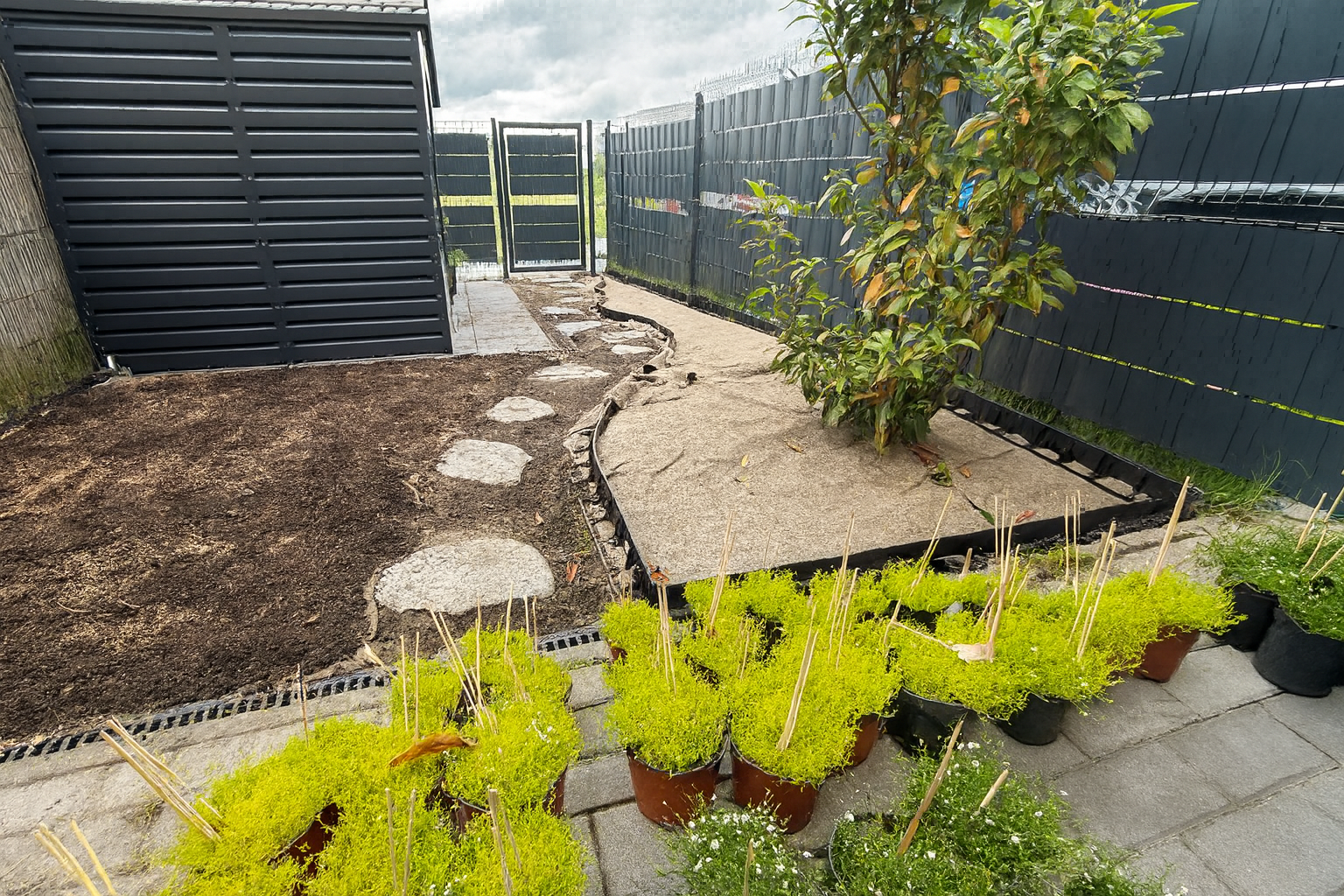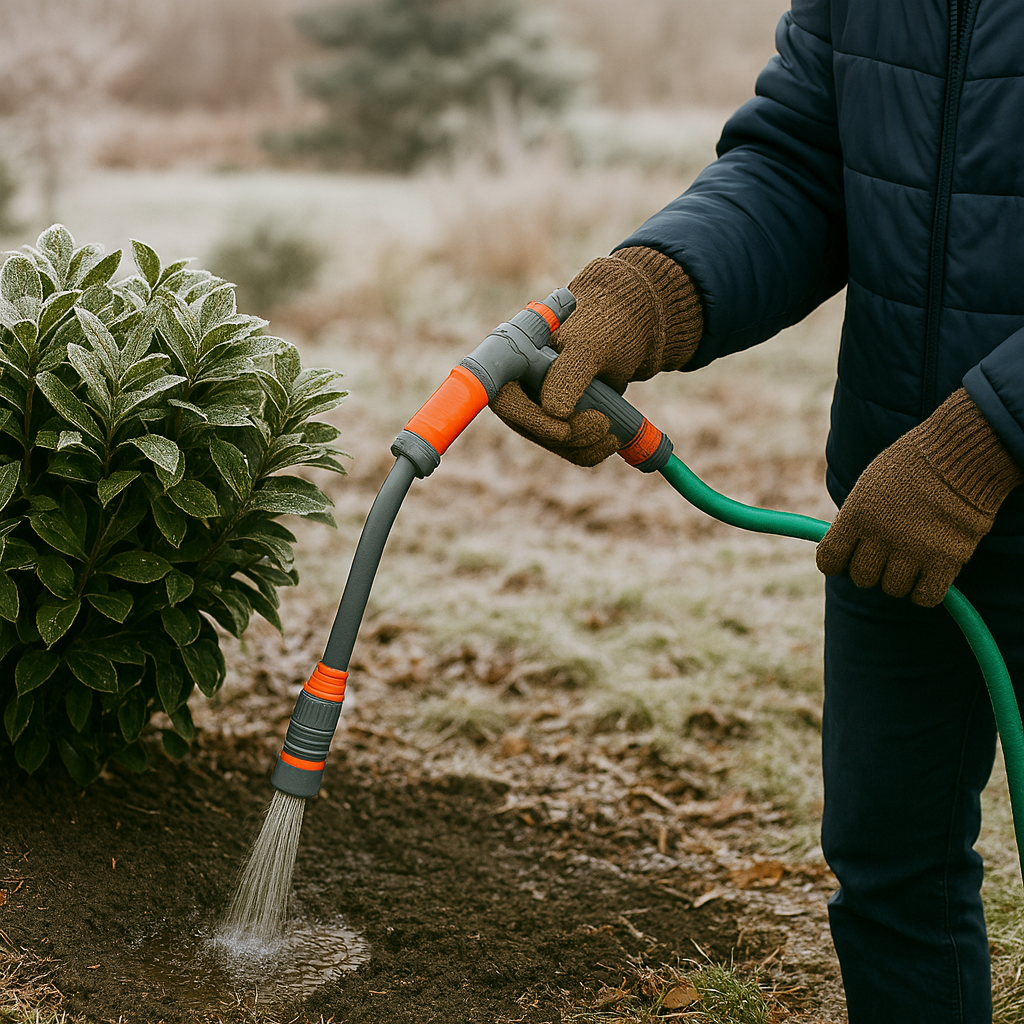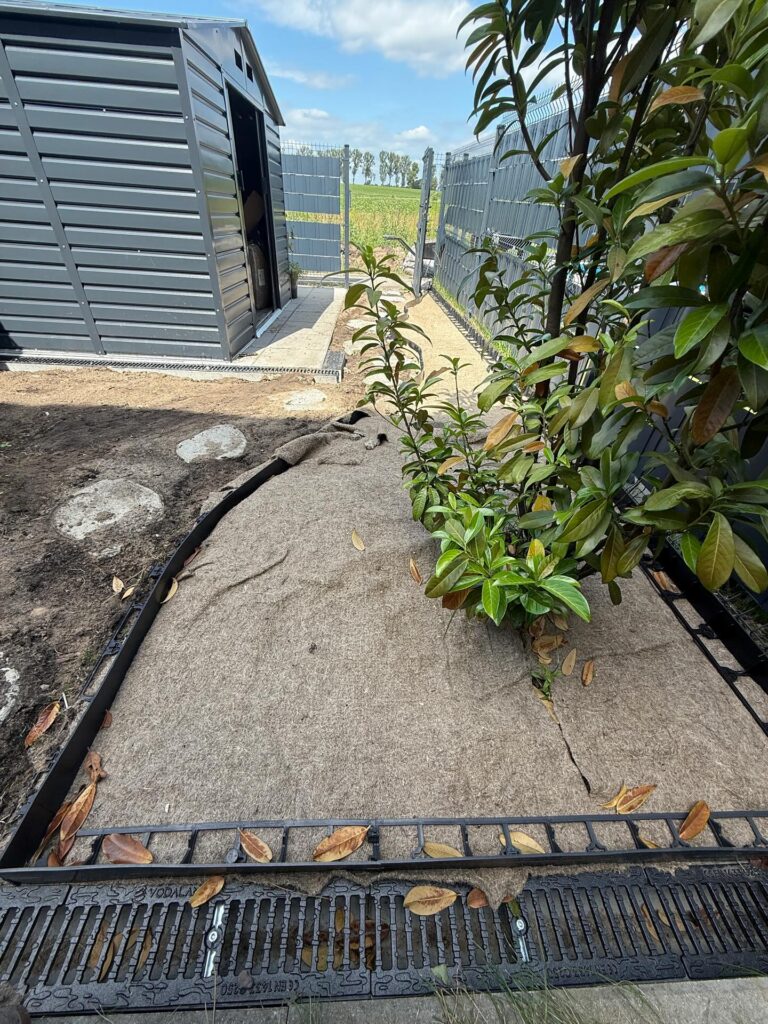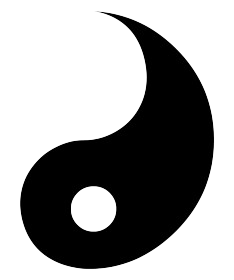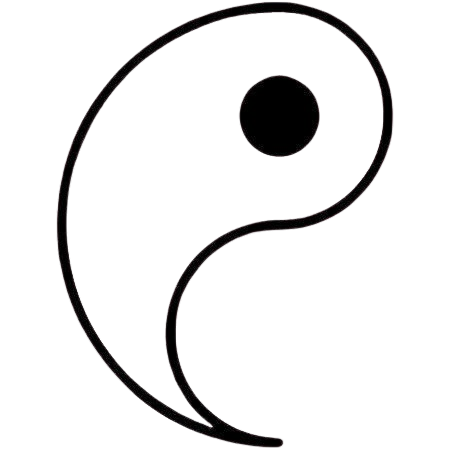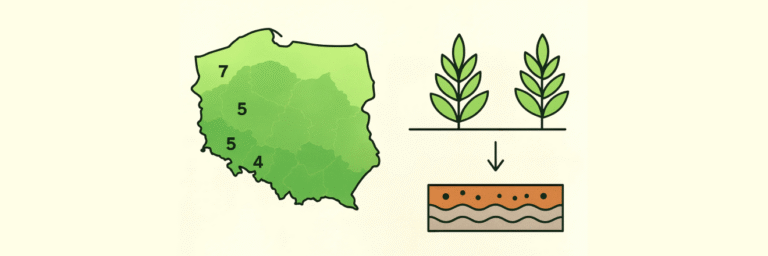In short:
- Mulching helps maintain water balance in heavy soil.
- Water precisely at the roots.
- Clean conifers once or twice a year.
- Winter watering saves evergreens.
- Limited space but want both beds and a hedge? You don’t always have to plant in a straight line.
- Choose honest products and trusted sources.
Heavy Soils – A Paradox You Can Overcome
Some gardens feel like walking on clay, where every watering session turns into a mud bath. Sounds familiar? That’s a clear sign you’re dealing with so-called heavy soil — a challenge that keeps many gardeners up at night.
But don’t worry. Instead of fighting nature, you can outsmart it.
Today, I’ll show you how to turn heavy soil from your biggest obstacle into your strongest ally.
The Paradox of Heavy Soil
Many homeowners make the same mistake: they buy plants dug straight from the ground, hoping to save 15–20% compared to potted ones — and then water them until it feels right.
The problem? Heavy, poorly draining soil simply isn’t built for that much water.
The result?
- The plant suffers severe transplant shock.
- Roots begin to rot, inviting fungal diseases.
- Adaptation never happens — and the garden starts to look like the aftermath of a small battlefield.
In nature, it’s not perfection that matters — it’s balance.
In forestry, no one panics over a 30% loss, but in a private garden that’s a disaster.
During my 17 years in horticulture, I analyzed every plant that didn’t make it.
From that long “school of mistakes,” my method was born — counterintuitive, but effective.
A Counterintuitive Solution: Mulch Instead of Watering
Yes, you read that right — not more water, but less.
Not more frequent watering, but smarter watering.
Mulching freshly planted greenery in heavy soils is the way to break free from the endless cycle. Mulch helps the soil retain moisture longer while still allowing it to breathe. All your plants need is a minimal amount of water to take root — nature takes care of the rest.
But beware — the “minimum” varies between species.
- Cherry laurel loves long-lasting moisture.
- Bamboo, on the other hand, hates standing water.
And that’s where the magic of balance begins.
How to Combine Plants with Different Needs
Let’s say you want to create a hedge with cherry laurel and bamboo.
It’s a combination of opposites — but it can work:
- Spacing: Plant them about 1 meter apart.
- Cherry laurel: Form a small watering mound — think of it like watering a potted plant.
- Bamboo: Add a layer of sand or gravel at the bottom of the planting hole (about 30% deeper than standard).
- Wind: If the site is exposed, don’t forget about winter watering for your evergreens.
Winter Watering – The Key to Survival
Sounds strange? It’s a treatment few people remember.
Autumn is the season when plants focus on developing their root systems. The water stored in their “reserve layers” helps them survive physiological drought — a winter phenomenon that occurs when frost limits water availability.
- Water regularly in late autumn — just as you would in spring.
- During winter (when there’s no snow cover), water every 3–4 weeks during thaws.
It’s a simple habit that can save your entire hedge.
How Not to Turn Your Hedge into a “Popsicle on a Stick”
When creating a garden, most people start with a hedge — and rightly so. But they often forget about its foundation.
Create a functional strip — fabric + mulch.
Without this base layer, plants lose their lower leaves and needles, resulting in the classic “popsicle effect” — green on top, bare at the bottom.
Why does this happen?
Competition with weeds for light and water.
Watering mistakes — especially watering over the foliage instead of at the roots.
The lack of mulch causes water to splash off the soil and onto the lower parts of the plants, encouraging decay and disease.
How to Water Without Killing Your Plants
At one point in my career, I started running a little experiment with my clients.
After finishing a hedge planting, I’d hand the homeowner a hose and ask:
“Show me how you’ll water it.”
In 90% of cases — they watered over the needles.
That’s the fastest way to invite fungal diseases.
Water settles on the bark, creating a humid microclimate — the perfect breeding ground for pathogens.
The rule is simple: always water at the roots.
Mulch – Nature’s Filter and Shield
Użycie ściółki, np. kory sosnowej, rozwiązuje kilka problemów jednocześnie:
- It absorbs and distributes water evenly,
- Protects plants from splashback and fungal infections,
- Helps maintain a slightly acidic pH — ideal for conifers.
As a side note — when I once checked the soil pH at a client’s property and saw a reading of 8.6, I instantly knew it was one of the main reasons their Thuja ‘Smaragd’ hedge had started turning yellow.
Cleaning Conifers – A Necessity, Not a Quirk
Yes, conifers do need cleaning.
Once or twice a year — ideally after winter and again after summer.
Removing dead needles helps prevent fungal growth.
I recommend using a leaf blower — fewer ticks, healthier plants.
You Don’t Always Need a Hedge
On small plots, finding a balance between privacy and aesthetics can be tricky.
Instead of building a wall of thujas, consider layered planting screens — a mix of plants of different heights that combine beauty with function.
A real-life example:
Garden hydrangea + columnar cherry laurel ‘Etna’ — a beautiful, balanced pairing for shaded areas.
Such mixed borders require a bit more planning, but the result feels natural, light, and truly unique.
I Saved the Biggest Surprise for Last
In 2024, I discovered a product from Kombinat Konopny — hemp shives and mulching mats made from industrial hemp fibers.
Why is it a game-changer?
- It has a neutral pH,
- Doesn’t alter soil acidity even after 1.5 years,
- It’s clean — no stones, dust, or “mystery extras,”
- And it introduces no weed seeds.
Anyone who’s ever worked with bagged pine bark from a big-box store knows exactly what I mean. Hemp mulch is for those who value honest materials and efficient work — a modern solution with roots in nature.

A Touch of Humor
But that’s not all — let’s move on to the humorous part.
Have you ever smelled a toad or a frog? That’s exactly how I often “smelled” coming home from work. It turns out that some suppliers, often importing bark from abroad, used open trailers — sometimes still covered in soil or turf from previous loads — and dumped the material straight onto the ground before bagging it.
That moist bark was probably paradise for the local amphibians. And so, whatever the worker scooped up with his shovel ended up right in the bag. Anyone who’s ever opened one of those knows the unique fragrance that greets you. Let’s just say, after a long day, I sometimes wondered if I’d accidentally opened a toad sanctuary in my garden.
Compared to that, tightly packed hemp shives feel like a luxury product — clean, dry, and blissfully free of “swamp life”. After all, when you buy mulch, you’re hoping for less work in the garden, not for raising amphibians in your flower beds. So being able to open a bag that smells neutral — not like a frog concert after the rain — truly feels like a milestone in gardening history.
Versatility and a Return to Nature
The mulching mats from Kombinat Konopny are a product that truly deserves attention — not only for their unique properties but also for their incredible versatility. With a neutral pH and a natural composition made from hemp fibers, they work perfectly in both traditional flower beds and modern garden designs, where aesthetics meet functionality. Their structure helps retain proper soil moisture, limits weed growth, and allows plants to breathe freely.
Interestingly, these mats also blend beautifully in Japanese or natural-style gardens, where they can serve as a base for creeping plants — such as junipers, cotoneasters, or euonymus. In such arrangements, they not only stabilize the soil but also emphasize the minimalist character of the space, without competing with the plants for attention. Another key advantage is their biodegradability — after about two seasons, they naturally decompose in the soil, leaving behind a healthy environment for further growth. It’s a solution that combines practicality, aesthetics, and the zero-waste philosophy — in harmony with the gardening approach of the future.
In the photo: three ways to use Kombinat Konopny’s hemp mulching mat:
- In flower beds
- For ground-cover plants (Sagina subulata, for example)
- As a drainage layer under the lawn
IMPORTANT
- Immediately after installation, cover the mat with mulch to protect it from sun, wind, dust, and weed seeds.
- The mulch layer should be at least 10–15 cm thick.
- Compact the mulch after spreading it.
- Mulch is a natural shield for your plants — but not a permanent one. In seasons with extreme weather, remember to replenish it regularly!
How to Create an Overflow-Resistant, Self-Sustaining Lawn
- Remove larger weeds.
- Spread a layer of sand and level the surface.
- Secure the mulching mat in place.
- Cover it with a mix of universal soil and sand in a 50/50 ratio.
- Use a seeder to spread grass seeds mixed with microclover, vermiculite, and mycorrhiza.
- Use a seeder to spread grass seeds mixed with microclover, vermiculite, and mycorrhiza.
- Gently roll the surface — ideally with an empty roller.
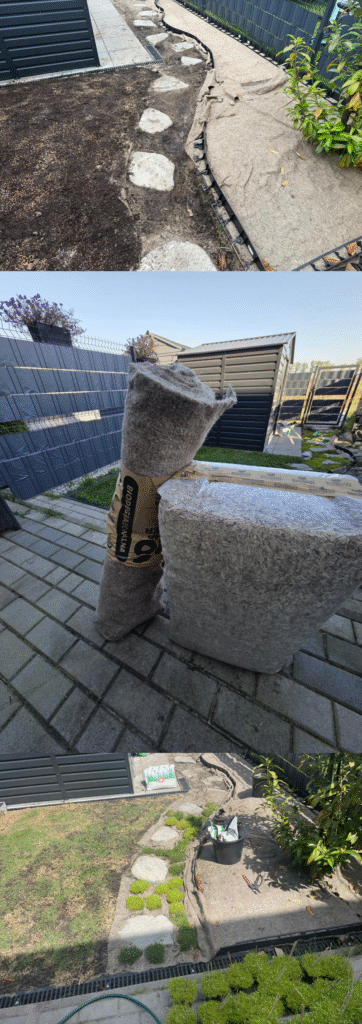
Diversity of Forms – Hybrid Borders
Don’t limit yourself to columnar shapes.
The cherry laurel ‘Rotundifolia’ has a naturally rounded form, making it perfect for the corners of a plot.
In front of it, you can plant lower species (50–80 cm) that will cover the base and add depth to the composition.
If you’re unsure which plants to pair together, use the e-Plant Catalog — an excellent tool for both professionals and beginners.
There you’ll find:
- Reliable plant descriptions,
- Filters by light exposure and soil moisture,
- Up-to-date sources for purchasing plants.
Summary
Heavy soil isn’t a sentence — it’s a challenge.
All it takes is understanding that less is more: less watering, more planning.
With the right mulch, well-chosen plant species, and an empirical approach, you can create a garden that’s resilient, balanced, and… nearly maintenance-free.
Want to learn more?
Use code ZENBOOK100 to get a free e-book: Kyoto-Style Garden
About the Author

Daniel Słodkiewicz – founder of the Zen Spotlight project, a gardener with over seventeen years of hands-on experience in the field, and a passionate advocate of nature, science, and an empirical approach to landscape design. In his work, he combines knowledge of hydrogeological conditions, climate, and plant biology with the philosophy of mindful garden design — creating spaces that adapt to their environment rather than resist it.
For more than a decade, he has helped clients analyze soil, select the right plant species, and build gardens that work with nature, not against it. Privately, he’s fascinated by East Asian culture, history, strength training, and topics related to neurodivergence and personal growth.

